Flowmaster 40 vs Super 40 vs 50: A Comparison
Stylethority is reader-supported. When you buy through links on the site, we may earn a commission.
Let’s be real here. Flowmaster mufflers are great, but having 15 variations of them is pretty darn confusing. There’s a certain point after which you’re overdoing it.
I’m starting a series of posts (with charts and sound) to tackle this confusion. Today, we’ll be looking at Flowmaster 40 vs Super 40, as well as how the 40 Series compares to the 50 Series.
Right off the bat: The Flowmaster Super 40 is the most fun to have muffler. It has a deeper, aggressive roar that doesn’t drone inside the cab. Its rich bass profile is what makes a street vehicle feel complete.
| Product | Image | ||
|---|---|---|---|
|
Most popular pick
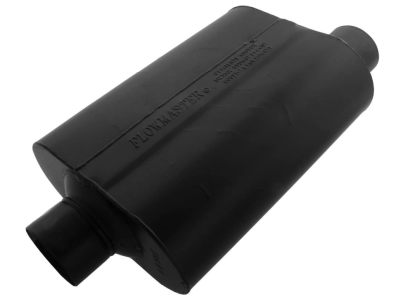
|
Flowmaster Super 40
|
Check Prices & Fit |
You are in no way limited to just the Super 40, of course.
The loudest option is the Flowmaster 40 Series. It’s aggressive both inside and outside, with a loud rumble that will rattle the streets.
For milder applications (passenger cars/commuters) there’s the 50 Delta Flow. Gentle inside the cab, it packs a moderate punch with a gutty, balanced growl on the outside.
Here’s a quick chart comparing Flowmaster’s 40 and 50 Series contestants:
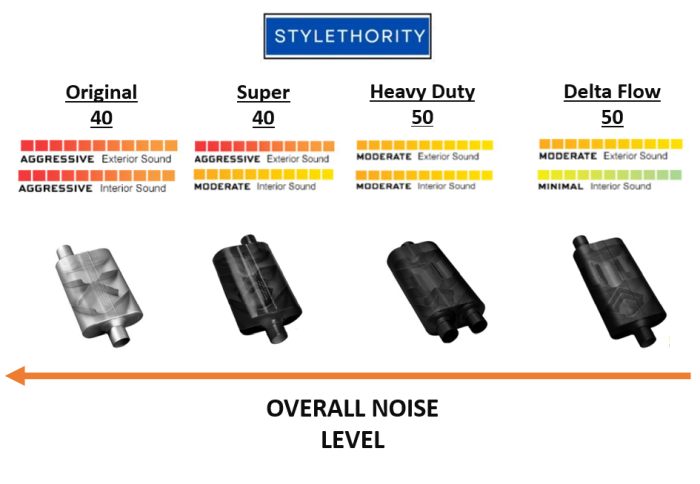
There’s been a lot of debate between the two 40 Series mufflers. Plenty of people prefer the balls-to-the-wall aggressiveness of the regular 40.
I’m in the Super 40 camp, but it’s always best to check for yourself. Here’s a short, but clean video that compares how both of them sound on an older stock Chevy Silverado.
Flowmaster 40 vs Super 40:
Is there such a thing as too loud?
The classic 40 Series was always a staple for the Flowmaster lineup. This muffler is designed to pack the biggest punch among the market’s mid-range muffler options.
High performance to the max, the Flowmaster 40 is targeted at people who want it LOUD. The aggressive bite of this muffler is unrivaled. Angry roars that will let the streets know you’re on.
The issue lies inside the vehicle, though. Aggressive as it is, the regular 40 can get…well, tiring. Its high noise levels cause it to drone quite a bit inside the cab. At one point, this can get irritating.
The Flowmaster Super 40 improves on two factors.
First, it retains the 40’s aggressiveness but its design achieves a deeper and richer tone. Equally powerful, it simply sounds more mature and fuller.
Second, the design kills some of the interior drone you’d get with the classic 40. Toning down the noise levels makes the Super 40 suitable for loudness enthusiasts who still want to be comfortable inside the cab.
There’s a reason why I’ve recommended it in other muffler-related posts.
Price-wise, the Super 40 is some 20-25% more expensive than the regular 40. Both are fully MIG-welded and you can get them either in stainless steel or aluminized steel.
In other words, they both share the same durability and quality construction. The difference lies in the interior sound levels and the exterior sound maturity.
| Product | Image | ||
|---|---|---|---|
|
Most popular pick

|
Flowmaster Super 40
|
Check Prices & Fit |
Flowmaster 40 vs 50 Series:
What does a 10 above mean?
So, what’s the biggest difference between a 40 and a 50?
First of all, the number of chambers. Flowmaster 50s follow a 3-chambered design compared to the 40’s 2 chambers.
Basically, this means that any Flowmaster 50 muffler will be quieter. That’s a good thing if your area is clamping down on decibel levels…
…or if you’re looking for a muffler to complement your daily commute/cruising vehicle.
The 50 Delta Flow is a prime example of a daily driving-friendly muffler. Its moderate tone is gentle and rich. It has just the right amount of mild bass.
| Product | Image | ||
|---|---|---|---|
|
Mild & Rich Sound
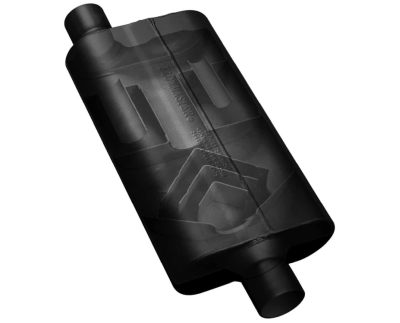
|
Flowmaster 50 Delta Flow
|
Check Prices & Fit |
The biggest difference is inside the cab, where the deeper sound meets lower decibel levels. Very comfortable for a daily driver.
Here’s a wonderful video that showcases how Flowmaster 40 vs 50 Delta Flow sound differs:
Flowmaster 50 Differences:
Delta Flow vs Heavy Duty
I already touched on how the Delta Flow version of the 50 Series performs.
Let’s talk about one overlooked and underrated member of the Flowmaster 50 family: the Heavy Duty muffler.
This one’s a total unit. Larger than other options, its primary purpose is to deal with large displacement engines and tone down their noise levels.
The Heavy Duty 50 Series (see the most popular one) is made with heavy-duty trucks in mind. It’s specifically designed for Hemi engine-running Dodge beasts, be it gasoline or diesel.
The three chambers are present here too, wrapped in a heavier, bigger body.
The Heavy Duty 50 has a louder rumble inside the vehicle. It flows less and isn’t as gentle as the Delta Flow. However, it’s not as loud and aggressive as the 40 Series either.
All in all, it’s a great take as a balanced, semi-aggressive muffler for a daily driver truck. It’s comparable to the Super 44 I’ve also talked about, with the perk of being specifically designed for big trucks.
The drawback is that it’s twice the price of any other 50 Series muffler due to its massive design and application purposes.
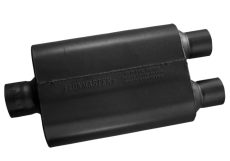
Twice the price of regular Flowmasters. Specifically designed to deal with truck engines and balancing out aggressive power with nice-sounding rumbles.
Closing words
Well, that’s a portion of the Flowmaster line-up covered!
All of these are decent mid-range mufflers following the same design and manufacturing quality.
I complained about Flowmaster having too many mufflers, but there’s a benefit to this too. The brand has nailed every single sound preference if you have some, but not much cash to spare. Flowmaster has more elaborate options than competitors like Thrush, for example.
If you’ve prepared the Big Bucks for your exhaust tinkering, Flowmaster might be too mundane for you. In this case, you can take a look at my post on Corsa and Borla. Significantly more expensive, their options take sound and durability to the next level.
As always with my posts, I’d be glad to hear about your own experiences. Let me know if you run any of the 40 or 50 Series Flowmasters and whether you’re satisfied with their sound.
- Woolx vs Smartwool: Discussing Some Details - October 4, 2023
- Best Struts For Honda Accord & Element: What Works - September 22, 2023
- Bilstein vs Monroe Shocks: My Opinion On What Works Best - September 19, 2023



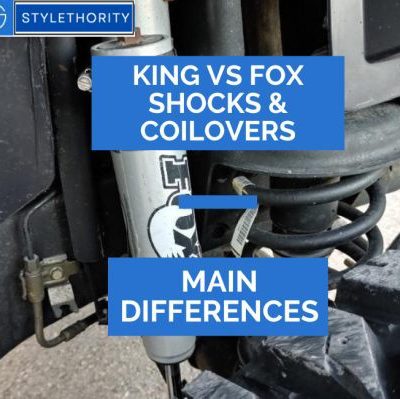


Back in 2007, I put a Flowmaster American Thunder system on my 98 GT Convertible. The sound was intoxicating and I couldn’t get enough of it. It had a sweet spot at 2400 RPM. These were silver cased mufflers.
Like a dummy, I sold that car, instantly missed it and searched for another one to replace it.
I found another , low mileage 98 GT back in 2013 and put on an American Thunder system which was identical to the last one except for having black cased mufflers. It has always just sounded ok but not anywhere as great as the first system I put on my previous 98 GT. Identical car, different sound…
I have been reading about Series 40 and Super 40’s, Series 44…black vs. silver cases…etcc.
Before spending money on a set of original Series 40’s in the silver case, can anyone tell me if “Original 40’s” with a silver case is going to finally give me the sweet noise I crave?
Hey there, J. Arthur!
First of all, thanks for sharing your personal story. I’m always happy to see people write a few paragraphs on their own experiences!
A ’98 GT Convertible sounds sexy – even more so today than back 15ish years ago. 🙂
Re: the sweet noise, I think there are two factors playing out here.
First, considering the big production volume, there are always bound to be some slight differences on the product (muffler) you get, I think. And second, I’m sure there have been slight alterations to what companies manufacture over a ~15 year period. So that might have contributed to the sound differences, too.
After all, a lot changed in the auto industry post the Great Financial Crisis…
In any case, I’m not sure if I or somebody else can guarantee you can get that same sound again. I sincerely wish you to find the right Series 40 that will achieve that, however!
Crossing my fingers,
Xander
Really good article. I currently have a muffler delete on my 2022 Chevy Silverado 1500 V8. My wife hates it :). Is a super 40 a happy medium where you still get the aggressive sound but not as loud as Muffler delete?
Hey JC,
Glad you found the post informative!
Yes, I believe the Super 40 would be the closest to what you’d want in such a situation. It honestly is a wonderful street muffler.
The 40 Delta Flow is also an option – it further reduces any droning occurrences, but is a notch less aggressive than the Super 40.
Good luck with trying them out (and I hope your wife will also like ’em more!)
Cheers,
Xander